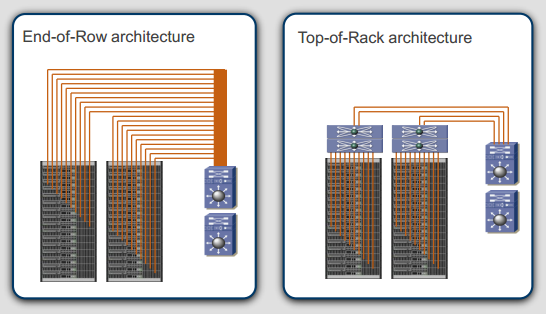This article is wholly based on ToR vs EoR switch comparison and difference.
What does TOR (Top of the Rack) stand for?
The EOR/MOR approach has been extended to include the TOR wiring method, commonly known as the “top of rack” wiring method. A jumper connects a rack-mounted server to each POD’s server cabinet’s higher-end via TOR wire. This uses 1-2 switches per switch at the upper end of each cabinet. A copper or fiber cable is used to link the switch’s upstream port to an aggregate switch or core switch in the EOR/MOR cabinet. In order to reduce the number of optical fibers or copper wires required to connect each server cabinet to the EOR/MOR network cabinet, the TOR wiring approach is used (4-6).
What does EOR mean?
EOR is the most common approach for integrating access switches into a data centre. As part of the EOR design, all of the hosts, servers, and minicomputers in the equipment cabinets are permanently linked through horizontal cables to a central switch cabinet (also known as a “switch cabinet”).
ToR vs. EoR: a comparison
Benefits
Because all server connections are terminated in a single rack, there are fewer cables running between the server and the network racks, lowering the overall cost of ToR. With a less number of cables, cable management is also simpler. Adding and removing wires has never been easier for technicians.
There are fewer devices in the EoR since not all racks need to be equipped with switches. Thus, the architecture requires less rack space. The cooling system’s workload is reduced when fewer devices are housed in the data center, resulting in lower electricity consumption.
Limitations
Each architecture, on the other hand, has some limits. Although the number of racks has decreased for ToR, the number of cables has remained the same. Switch management may be a bit of a challenge. Additional rack space is required for the placement of the switches in the ToR method.
The Layer 2 traffic efficiency of EoR is less than that of ToR. Servers in the same rack and virtual local area network need to communicate with each other, therefore the traffic will first flow via an aggregation switch and then back again. In an EoR architecture, fewer switches mean more wires between racks, increasing the likelihood of a cable tangle. The cable management process necessitates the use of highly trained specialists.
ToR vs EoR Physical Deployments
Deployment of ToR
High-speed and independent ToR switches connected to the main network are often required for a redundant access switch implementation. Rack-mounted access switches link servers to each other. Another is the use of ToR deployment in conjunction with server link aggregation. The virtual chassis consists of two high-speed ToR switches. Using link aggregation technology, servers are able to connect to both switches on top of the rack.
Deployment of EoR
EoR access switch deployment is standard practice for extending all server connections to the end of row switch rack. You may even deploy a virtual chassis to support existing wire if necessary. I hope you like reading on ToR vs EoR switch comparison and difference.

